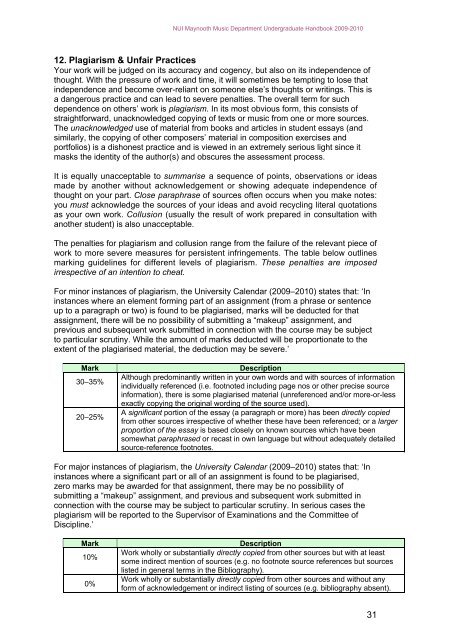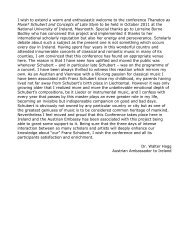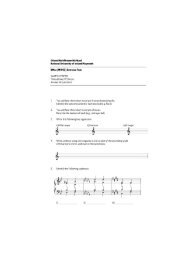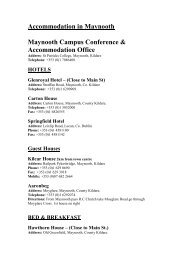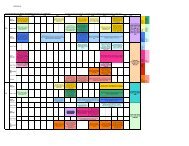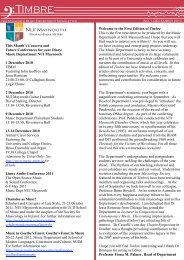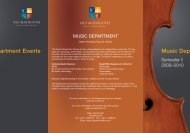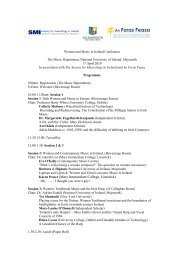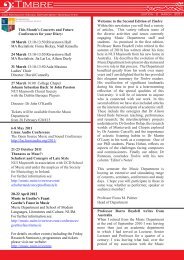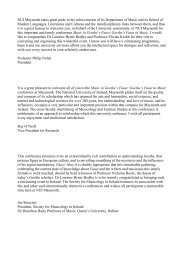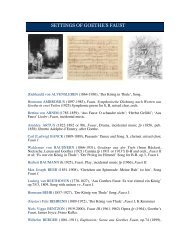UNDERGRADUATE STUDENT HANDBOOK - Music
UNDERGRADUATE STUDENT HANDBOOK - Music
UNDERGRADUATE STUDENT HANDBOOK - Music
Create successful ePaper yourself
Turn your PDF publications into a flip-book with our unique Google optimized e-Paper software.
NUI Maynooth <strong>Music</strong> Department Undergraduate Handbook 2009-2010<br />
12. Plagiarism & Unfair Practices<br />
Your work will be judged on its accuracy and cogency, but also on its independence of<br />
thought. With the pressure of work and time, it will sometimes be tempting to lose that<br />
independence and become over-reliant on someone else’s thoughts or writings. This is<br />
a dangerous practice and can lead to severe penalties. The overall term for such<br />
dependence on others’ work is plagiarism. In its most obvious form, this consists of<br />
straightforward, unacknowledged copying of texts or music from one or more sources.<br />
The unacknowledged use of material from books and articles in student essays (and<br />
similarly, the copying of other composers’ material in composition exercises and<br />
portfolios) is a dishonest practice and is viewed in an extremely serious light since it<br />
masks the identity of the author(s) and obscures the assessment process.<br />
It is equally unacceptable to summarise a sequence of points, observations or ideas<br />
made by another without acknowledgement or showing adequate independence of<br />
thought on your part. Close paraphrase of sources often occurs when you make notes:<br />
you must acknowledge the sources of your ideas and avoid recycling literal quotations<br />
as your own work. Collusion (usually the result of work prepared in consultation with<br />
another student) is also unacceptable.<br />
The penalties for plagiarism and collusion range from the failure of the relevant piece of<br />
work to more severe measures for persistent infringements. The table below outlines<br />
marking guidelines for different levels of plagiarism. These penalties are imposed<br />
irrespective of an intention to cheat.<br />
For minor instances of plagiarism, the University Calendar (2009–2010) states that: ‘In<br />
instances where an element forming part of an assignment (from a phrase or sentence<br />
up to a paragraph or two) is found to be plagiarised, marks will be deducted for that<br />
assignment, there will be no possibility of submitting a “makeup” assignment, and<br />
previous and subsequent work submitted in connection with the course may be subject<br />
to particular scrutiny. While the amount of marks deducted will be proportionate to the<br />
extent of the plagiarised material, the deduction may be severe.’<br />
Mark Description<br />
Although predominantly written in your own words and with sources of information<br />
30–35%<br />
individually referenced (i.e. footnoted including page nos or other precise source<br />
information), there is some plagiarised material (unreferenced and/or more-or-less<br />
exactly copying the original wording of the source used).<br />
A significant portion of the essay (a paragraph or more) has been directly copied<br />
20–25%<br />
from other sources irrespective of whether these have been referenced; or a larger<br />
proportion of the essay is based closely on known sources which have been<br />
somewhat paraphrased or recast in own language but without adequately detailed<br />
source-reference footnotes.<br />
For major instances of plagiarism, the University Calendar (2009–2010) states that: ‘In<br />
instances where a significant part or all of an assignment is found to be plagiarised,<br />
zero marks may be awarded for that assignment, there may be no possibility of<br />
submitting a “makeup” assignment, and previous and subsequent work submitted in<br />
connection with the course may be subject to particular scrutiny. In serious cases the<br />
plagiarism will be reported to the Supervisor of Examinations and the Committee of<br />
Discipline.’<br />
Mark Description<br />
10%<br />
Work wholly or substantially directly copied from other sources but with at least<br />
some indirect mention of sources (e.g. no footnote source references but sources<br />
listed in general terms in the Bibliography).<br />
0%<br />
Work wholly or substantially directly copied from other sources and without any<br />
form of acknowledgement or indirect listing of sources (e.g. bibliography absent).<br />
31


